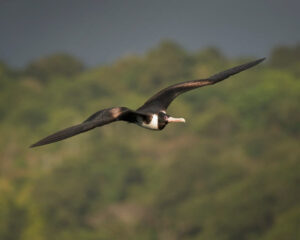The Christmas Island Frigatebird (Fregata andrewsi) is a globally threatened migratory seabird; listed as Vulnerable by the International Union for the Conservation of Nature (IUCN). In Australia, the species is listed as Endangered, Marine and Migratory under Australia’s national environmental law – the Environment Protection and Biodiversity Conservation Act 1999. The species is also listed on Appendix I of the Convention on the Conservation of Migratory Species of Wild Animals, and on Appendix III of the East Asian-Australasian Flyway Partnership document as a member of Fregatidae.
The Christmas Island Frigatebird is a threatened migratory seabird as it has a small breeding population (latest estimate 669 individuals in 2021) that is continuing to decline. Females are likely to only breed at two-year intervals. The species is a colonial nester, breeding on just one island (Christmas Island in Australia’s jurisdiction). The species has three main nesting colonies within small patches of forest in the north-east of Christmas Island. Other historical nesting colonies on Christmas Island are either greatly reduced or no longer occupied. When birds are not breeding on Christmas Island, the species has been found across the area of the Indo-Malay Archipelago over the Sunda Shelf to South China Sea, Andaman Sea, Gulf of Thailand, Sulu Sea, off the coast of south-west Sulawesi and the Philippines. The seas around West Java, Indonesia also seem to be particularly important during the non-breeding season, especially in Jakarta Bay.
To coordinate and enhance conservation efforts to benefit Christmas Island Frigatebirds, the Australian Government has led the developed of a Single Species Action Plan (SSAP) to enhance protection of the Christmas Island Frigatebird among Range States. The SSAP will assist by identifying and prioritising national and international management and research actions across key Range States to ameliorate anthropogenic threats, such as bycatch in fishing gear, illegal hunting, prey depletion due to fishing, heavy metal contamination, marine debris and weed encroachment on roosting habitat, across the species entire range.
Key management and research actions identified include preventing the introduction of a new disease to the breeding site, preventing disturbance to terrestrial habitat (e.g vegetation clearance), stakeholder engagement to support and improve collaboration across the species range and furthering our understanding of threats that may impact the Christmas Island Frigatebird.
The SSAP has been submitted by the Governments of Australia and the Philippines for consideration and endorsement at EAAFP MOP11 to be held in Brisbane, Australia in March 2023. To read the MOP 11 draft decision paper click here.

Adult female Christmas Island Frigatebird. Image credit: G.B Baker

Juvenile Christmas Island Frigatebird. Image credit: G.B Baker
Article prepared by the Australian Government.





